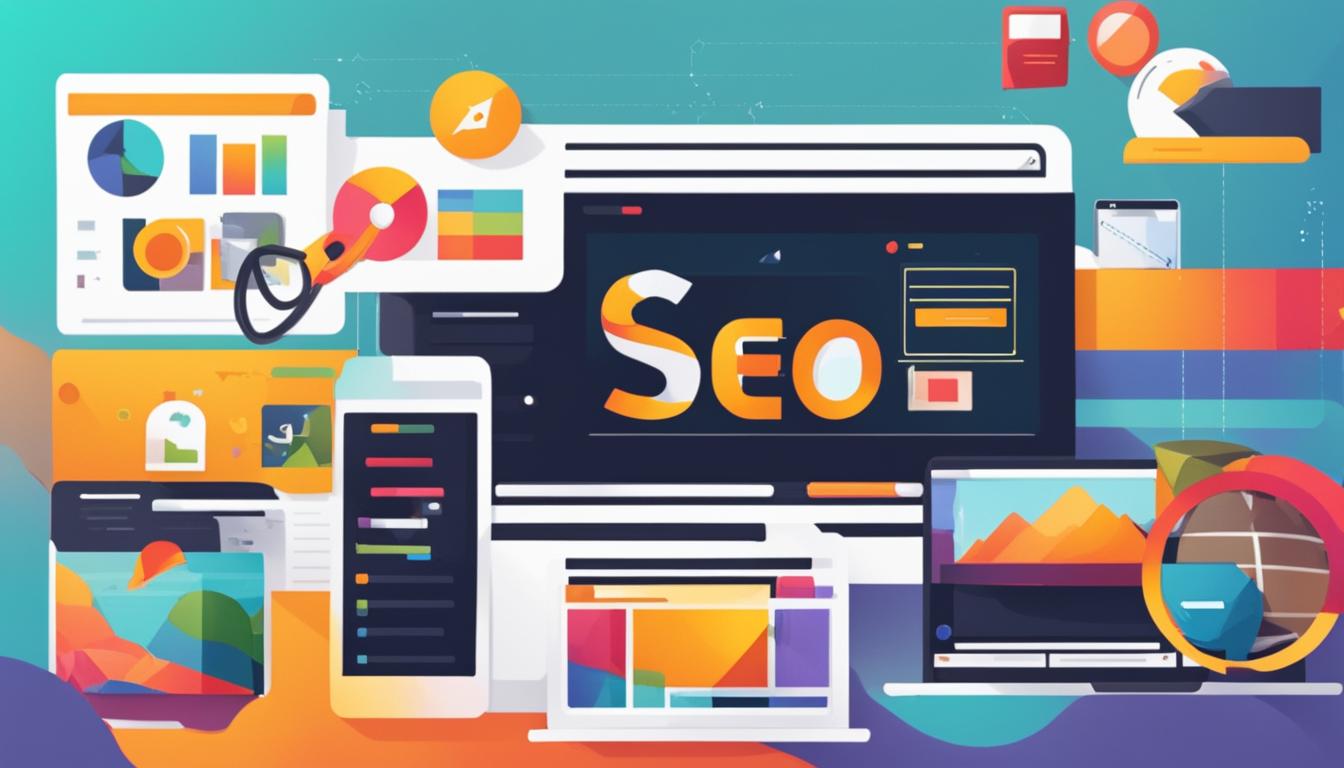Are you prepared to embark on a journey toward mastering SEO with us?
In this article, we’ll dive into the world of on-page SEO optimization for creative industries. We’ll uncover the secrets to skyrocketing your website’s visibility and attracting the right audience.
Get ready to unlock the full potential of your website as we explore keyword research, meta tag optimization, content creation, and more.
Buckle up, because we’re about to embark on a thrilling ride to SEO mastery!

Key Takeaways
- Keyword research and competitive analysis are crucial for understanding the search landscape in creative industries and attracting highly qualified traffic.
- Optimizing meta tags and descriptions is essential for improving visibility in search results and attracting both search engines and users.
- Creating compelling and relevant content, with the use of high-quality images, videos, and storytelling techniques, helps engage the audience on a deeper level and convey brand values.
- Enhancing website speed and performance through optimization techniques, such as reducing image file size and implementing caching strategies, is important for improving on-page SEO.
Keyword Research and Analysis
When conducting keyword research and analysis, we should begin by identifying relevant search terms that align with our creative industry. This involves performing a competitive analysis to understand what keywords our competitors are ranking for and how we can differentiate ourselves. By examining the keywords they target and the content they produce, we can gain valuable insights into our own keyword strategy.
Additionally, it’s crucial to focus on long tail keywords, which are longer and more specific phrases that have lower search volume but higher conversion rates. These keywords allow us to target a more niche audience and increase the chances of attracting highly qualified traffic.
Optimizing Meta Tags and Descriptions
To optimize our on-page SEO for creative industries, we can enhance our visibility in search results by optimizing meta tags and descriptions.
Meta tags are HTML elements that provide information about a webpage to search engines. By writing persuasive copy and including relevant keywords in our meta tags, we can attract the attention of both search engines and users.

Descriptions, on the other hand, are the brief summaries that appear beneath the title of a webpage in search results. By crafting compelling descriptions that accurately represent the content of our page, we can maximize click-through rates and encourage users to visit our website.
Optimizing meta tags and descriptions is a crucial step in our on-page SEO strategy, as it sets the stage for creating compelling and relevant content that will ultimately drive traffic to our site.
Creating Compelling and Relevant Content
We prioritize the creation of compelling and relevant content to optimize our on-page SEO for creative industries. To achieve this, we employ engaging visuals and storytelling techniques that captivate our audience.
Here’s how we do it:

- Engaging visuals: We understand the power of visuals in capturing attention and conveying messages effectively. By incorporating high-quality images, videos, and infographics, we enhance the overall user experience and encourage visitors to stay on our website longer.
- Storytelling techniques: We believe in the power of storytelling to connect with our audience on a deeper level. By weaving narratives into our content, we create an emotional connection, evoke curiosity, and leave a lasting impression. Through compelling stories, we’re able to convey our brand’s values, evoke emotions, and engage our audience in a meaningful way.
Enhancing Website Speed and Performance
To improve our on-page SEO for creative industries, we focus on optimizing website speed and performance. A slow-loading website can result in a poor user experience and higher bounce rates.
One effective technique is image optimization, where we reduce the file size of images without compromising their quality. This can be achieved by using image compression tools or choosing the appropriate file format.
By implementing caching strategies, we can store certain elements of our website, such as images and stylesheets, in the user’s browser. This allows for faster loading times upon subsequent visits.
Additionally, minimizing the use of external scripts and optimizing code can also contribute to improved website speed.

Implementing Internal Linking Strategies
One important aspect to consider when optimizing on-page SEO for creative industries is the implementation of internal linking strategies. Internal linking refers to the practice of linking one page of a website to another page within the same website. This technique not only helps users navigate through the website easily but also plays a crucial role in improving search engine rankings.
Here are three key reasons why internal linking strategies are important:
- Improves website structure: Internal links create a hierarchical structure within a website, making it easier for search engines to crawl and index the pages.
- Increases website authority: By linking to relevant and high-quality pages within the website, internal linking helps to establish website authority and credibility.
- Optimizes anchor text: Anchor text plays a vital role in SEO. By using descriptive and keyword-rich anchor text in internal links, you can optimize the relevance and visibility of your website.
Frequently Asked Questions
How Can I Optimize My Website for Mobile Devices in the Creative Industry?
To optimize our website for mobile devices in the creative industry, we focus on two key aspects: optimizing website speed and ensuring a responsive design. These factors are crucial for a seamless user experience and improved search engine rankings.
What Are Some Effective Strategies for Building Backlinks in the Creative Industry?
Building relationships and influencer collaborations are key strategies for building backlinks in the creative industry. We’ve learned that 91% of consumers trust influencers, making them powerful allies in boosting SEO and driving traffic to your website.

Are There Any Specific SEO Considerations for E-Commerce Websites in the Creative Industry?
There are specific SEO considerations for e-commerce websites in the creative industry. It’s crucial to optimize on-page elements like meta tags and keywords. Additionally, user experience holds great importance in the creative industry, so make your website visually appealing and easy to navigate.
How Can I Optimize Images on My Website to Improve SEO in the Creative Industry?
To optimize images for SEO in the creative industry, we focus on optimizing image alt tags and reducing image file size. These techniques improve website performance and ensure that search engines can understand and rank our visual content effectively.
What Are Some Best Practices for Optimizing URLs and Site Structure in the Creative Industry?
To optimize URLs and site structure in the creative industry, we focus on creating concise, descriptive URLs and organizing content into logical categories. This ensures easy navigation and boosts search engine rankings.
What Role Does Website Infrastructure Play in Optimizing On-Page SEO for Creative Industries?
Website infrastructure optimization for seo plays a crucial role in optimizing on-page SEO for creative industries. A well-structured and technically sound website infrastructure ensures search engines can easily crawl and index your webpages. This improves your website’s visibility in search engine results and helps drive organic traffic. Additionally, optimized website infrastructure enhances user experience, leading to higher engagement and conversions. To succeed in the competitive landscape, creative industries must prioritize website infrastructure optimization for SEO.
Conclusion
In conclusion, when it comes to optimizing on-page SEO for creative industries, it’s all about finding the perfect balance.

Remember the age-old saying, ‘Creativity is intelligence having fun.’
By conducting thorough keyword research, optimizing meta tags and descriptions, creating compelling content, improving website speed, and implementing internal linking strategies, you can ensure that your creative website stands out and attracts the right audience.
So let your creativity shine and watch your online presence soar!









